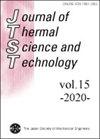The shape and fluctuation of hydrogen-propane-butane-air lean premixed flames formed on a flat flame burner
IF 1.2
4区 工程技术
Q3 THERMODYNAMICS
引用次数: 0
Abstract
researchers. The important parameters of premixed flames, i.e. the burning velocity, Markstein length and flame thickness, were experimentally obtained 2014), and the emission and heat transfer were estimated 2012). Moreover, the mixture of hydrogen and hydrocarbon is also gathering attention, and several research papers have published Abstract In this paper, the characteristics of hydrogen-propane-butane-air lean premixed flames on a flat flame burner were experimentally studied. To elucidate the shape and fluctuation of premixed flames, the cell width, RMS of fluctuation, peak frequency and reconstructed attractor were obtained from the direct photographic images and time series of light emission intensity. The cellular flames were observed at sufficiently low equivalence ratios; the flat flames were found under the other conditions. When the concentration of hydrogen was higher, the flat flames were formed at lower equivalence ratios. As the equivalence ratio became lower, the cell width and RMS increased in the range of cellular flames, which was due to high instability level. At low (high) equivalence ratios, moreover, the size of attractor was large (small) and the trajectory was unstable (quasi periodic). The experimental results revealed the instability characteristics of hydrogen-propane-butane-air lean premixed flames, and the obtained findings were applicable to the safe control of lean premixed flames.在平焰燃烧器上形成氢-丙烷-丁烷-空气稀薄预混火焰的形状和波动
研究人员。通过实验获得了预混火焰的重要参数,即燃烧速度、Markstein长度和火焰厚度(2014),并对其发射和传热进行了估计(2012)。摘要本文在平焰燃烧器上对氢-丙烷-丁烷-空气稀薄预混火焰的特性进行了实验研究。为了阐明预混火焰的形状和波动,从直接摄影图像和光发射强度时间序列中获得了细胞宽度、波动的均方根、峰值频率和重建吸引子。在足够低的等效比下观察到细胞火焰;平坦的火焰是在其他条件下发现的。当氢浓度较高时,在较低的当量比下形成扁平火焰。当等效比越低时,胞内火焰范围内的胞宽和均势均增大,这是由于胞内不稳定程度越高所致。在低(高)等价比下,吸引子的大小大(小),轨迹不稳定(准周期)。实验结果揭示了氢-丙烷-丁烷-空气稀薄预混火焰的不稳定特性,所得结果可用于稀薄预混火焰的安全控制。
本文章由计算机程序翻译,如有差异,请以英文原文为准。
求助全文
约1分钟内获得全文
求助全文
来源期刊
CiteScore
2.30
自引率
8.30%
发文量
0
审稿时长
5 months
期刊介绍:
JTST covers a variety of fields in thermal engineering including heat and mass transfer, thermodynamics, combustion, bio-heat transfer, micro- and macro-scale transport phenomena and practical thermal problems in industrial applications.

 求助内容:
求助内容: 应助结果提醒方式:
应助结果提醒方式:


